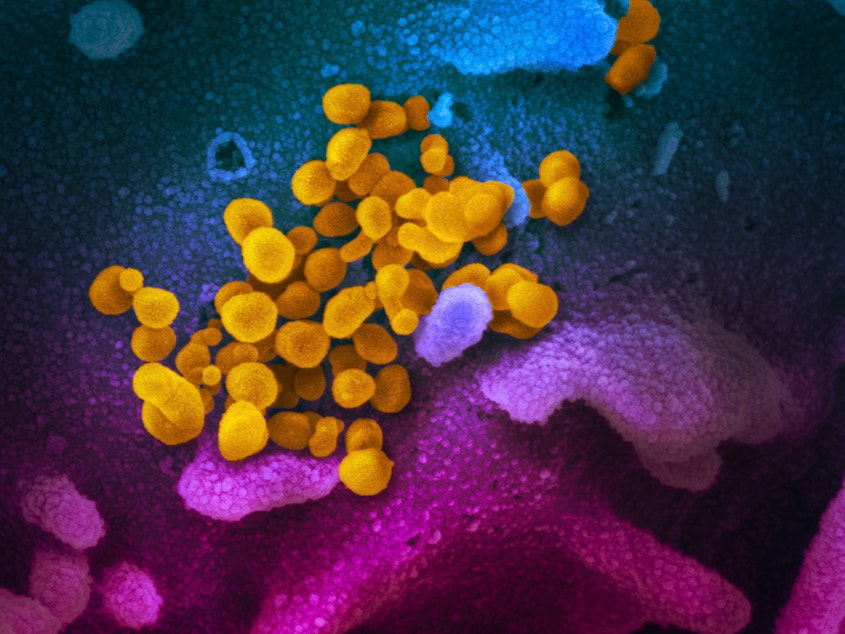Coronavirus Testing: What To Know As It Becomes Available Across The U.S.

After a slow initial rollout, test kits for the new coronavirus are now becoming more widely available in the U.S. That means a big surge in testing is coming – one that will likely cause a significant increase in identified cases of the COVID-19 illness.
Here are some things to know about the tests.
If I think I might have the coronavirus, should I get tested?
The most common initial symptoms of COVID-19 are fever, a dry cough and shortness of breath. Call your doctor or your local health department if you believe you might have the virus, and they will advise the best course of action.
It's important to remember that not everyone who get infected gets sick and symptomatic. Also, it's flu season, so lots of people with flu-like symptoms have just that: the flu.
Sponsored
And to guard against becoming infected, start by practicing good hygiene: Wash your hands with soap and water frequently. Stay home from work or school if you're sick. It's possible you could get the virus and not know it because your symptoms are mild — so it's important not to pass the virus on to others who could be especially vulnerable to it.
How does the test work — do you get tested at a hospital?
If a patient is suspected of having COVID-19, they will most likely be tested at a hospital.
A medical professional will swab inside a patient's nostril and throat. If the patient has a wet cough, they'll also collect sputum (the mixture of saliva and mucus that is coughed up). These samples are then examined in a lab for genetic material that indicate whether the coronavirus is present.
The Centers for Disease Control and Prevention says it is now shipping test kits to labs across the country and that they should be in state and local labs by the end of the week. The Food and Drug Administration has also just given permission to advanced labs — mostly at academic hospitals — to use their own tests if they have developed them.
Sponsored
So who decides who'll be tested?
Right now, it's up to state and local health departments to decide who to test. The CDC provides clinical criteria to healthcare professionals for determining whether someone should be classified as a person under investigation for COVID-19.
Unless someone is very sick and/or has reason to believe they've been exposed to the virus, the doctor is likely to decide the person does not need to be tested for coronavirus.
The first suspected U.S. case of coronavirus through "community spread" was left undiagnosed for days because a request for testing wasn't initially granted. Community spread indicates the person was infected despite having no history of travel to affected areas or exposure to someone known to have the COVID-19 illness — so the cause of their infection is unknown.
Not all people who want to be tested will be, at least in the short term. Some people have recently told NPR that they had asked to be tested for the virus because they were experiencing some flu-like symptoms, but they were not tested.
Sponsored
Will the test tell me if I had coronavirus but got better?
No. The test will show only whether you are currently infected with the virus. It will not show whether you had the virus in the past.
What does the test's wider availability mean for the U.S.?
As testing becomes more accessible, it's likely the tests will find infections around the country – including cases that have gone undetected for a while.
A genetic analysis of the virus in Washington state published Saturday found the virus might have been circulating there for weeks and that hundreds of people might already be infected.
Sponsored
The test also means public health authorities should be able to catch new cases more quickly.
How many tests are available?
The CDC says it has enough kits to test at least 75,000 people, and more are on order.
Each lab that orders a diagnostic panel from the CDC to test for COVID-19 will receive one diagnostic panel initially, and each panel can test 700 to 800 patient specimens.
Why hasn't broader testing been available until now?
Sponsored
The first test kits sent by the CDC to state and local labs didn't work as planned. It was a three-step process, and the third step was causing problems. The FDA subsequently authorized the use of just the first and second steps to provide a definitive diagnostic.
That set the U.S. back several weeks, and public health officials lost a crucial window to contain the virus and prevent it from getting a foothold in the U.S.
Secondly, the CDC was using very strict criteria to determine who could be tested. That's what happened with the "community spread" case last month at UC Davis Medical Center in Sacramento, Calif.
The CDC has now revised the criteria for testing to include people who are so sick that they need to be hospitalized but don't know how they might have been exposed.
NPR's Rob Stein and Richard Harris contributed to this report. [Copyright 2020 NPR]


